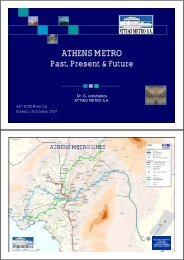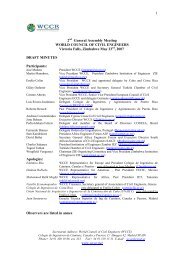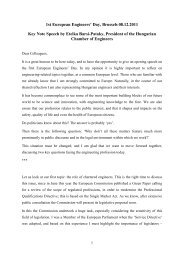A Closer Look at Prevailing Civil Engineering Practice - European ...
A Closer Look at Prevailing Civil Engineering Practice - European ...
A Closer Look at Prevailing Civil Engineering Practice - European ...
You also want an ePaper? Increase the reach of your titles
YUMPU automatically turns print PDFs into web optimized ePapers that Google loves.
A <strong>Closer</strong> <strong>Look</strong> <strong>at</strong> <strong>Prevailing</strong> <strong>Civil</strong> <strong>Engineering</strong> <strong>Practice</strong>, Wh<strong>at</strong>, Why and How<br />
Vincent T. H. CHU<br />
Chapter 7. Slopes and Excav<strong>at</strong>ion<br />
1. In braced excav<strong>at</strong>ion, why is Rankine’s theory of l<strong>at</strong>eral earth<br />
pressure not applicable<br />
In braced excav<strong>at</strong>ion, sheetpiling is constructed <strong>at</strong> the first place, followed<br />
by the install<strong>at</strong>ion of struts as excav<strong>at</strong>ion proceeds. Following the<br />
install<strong>at</strong>ion of first row of struts, the depth of excav<strong>at</strong>ion is small so th<strong>at</strong><br />
there is no major yielding of soils. However, as further excav<strong>at</strong>ion takes<br />
place, soils yield before the install<strong>at</strong>ion of n th row of struts. The first row of<br />
struts prevents yielding near the ground surface. As such, deform<strong>at</strong>ion of<br />
wall increases with depth with the smallest <strong>at</strong> the ground level. Owing to<br />
the effect of construction method of braced excav<strong>at</strong>ion, it differs from the<br />
deform<strong>at</strong>ion condition of Rankine’s theory. This is <strong>at</strong>tributed to arching<br />
effects in which there exists upward redistribution of loads. The upper part<br />
of braced excav<strong>at</strong>ion is in the st<strong>at</strong>e of elastic equilibrium while the lower<br />
part is in the st<strong>at</strong>e of plastic equilibrium.<br />
2. How could counterforts in counterfort retaining wall assist in<br />
resisting earth pressure<br />
Counterforts are used for high walls with height gre<strong>at</strong>er than 8 to 12 m.<br />
They are also used in situ<strong>at</strong>ions where there is high l<strong>at</strong>eral pressure, i.e.<br />
where the backfill soils are heavily surcharged.<br />
The counterforts tie the base slab and wall stem together and they act as<br />
tension bracing which strengthen the connection between wall and base<br />
slab. The counterforts help to reduce bending moment and shear forces<br />
induced by soil pressure to the retaining wall. Moreover, it also serves to<br />
increase the self-weight of the retaining wall which adds stability to the<br />
retaining wall.<br />
3. Wh<strong>at</strong> is the basic mechanism of soil nails in improving soil<br />
stability<br />
Soil nails improve slope stability by:<br />
(i) Partial increase the normal force and shear resistance along<br />
potential slip surface in frictional soils.<br />
(ii) Direct reduction of driving force along potential slip surface for<br />
cohesive and frictional soils.<br />
53
















